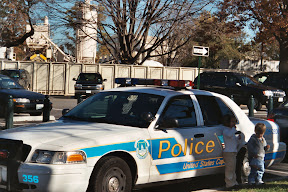 |
| From Without a roa... |
But this latest shooting spree reminded me that there is one conflict zone that is far more dangerous than many of the world’s most troubled hotspots – the American urban jungle. And the randomness of the wacko with an automatic weapon or the stray bullet in a ‘drive-by’ is, in many ways, just as terrifying as any terror attack.
In fact, during a visit to Washington, DC, I realised that this one-time ‘murder capital’ of the world was once the most dangerous city in the world, until George W Bush invaded Iraq and passed on the crown to Baghdad! Perhaps rather than invading other countries with a reckless gung-ho attitude, he could’ve cleaned up the mess just a few short blocks from the White House by addressing the lax gun laws, socio-economic equalities and cultural attitudes that fuel violent crime in the USA. No matter what the gun lobby says, firearms do kill people.
In 1998, Washington, DC, reached the staggering height of 69.3 murders per 100,000 residents, according to an international survey by the UK Home Office. In that same survey, I was glad to learn that Brussels (where I work) came bottom, with only 0.4 murders per 100,000 inhabitants!
This time the perpetrator was a South Korean but all the sad examples that have come to pass in America in the last few years alone – Columbine, the Washington Sniper, etc. – reveal that a depressing pattern. It is the place – and the easy access it affords to those of an unstable disposition – rather than ethnicity that counts here.
Comparative carnage
To compare the US situation with Israel and Palestine, I got out my calculator, looked up some stats and did the maths. I found that it is statistically more likely for the average person to get killed in an American city than in an Intifada-related incident. In the USA, according to the American Bureau of Justice, cities with a population of over 1 million had a murder rate of 13.2 per 100,000 per year.
Based on a rough estimate of about 4,000 dead Palestinians and 1,000 dead Israelis during the Intifada between 2000 and 2006, and a total Israeli/Palestinian population of nearly 10 million, that would work out at a political murder rate of 8.4 per 100,000 per year on average.
This is not meant to belittle the suffering the Israeli-Palestinian conflict inflicts. But violence-wise, it is fairly low-intensity, compared with many other troubled areas of the world. The trouble with Israel and Palestine is finding a way to divide up the land equitably between a people who have trouble getting over the loss of what had, since time immemorial, been theirs and another who have trouble giving up enough of what had, for centuries, been their unattainable dream.
©Khaled Diab for text and Katleen Maes for image.

4 comments:
Okay, but you statistics are only going to work if you stay on the Israeli side of the green line.
"Culture of violence, easy access to weapons, too many guns on the street, low value of life. . ."
More applicable to Gaza than America, if you ask me, but I won't tell your family.
There is something else happening in America that I think has more to do with the random and ferocious acts of violence. In general, Americans are far less violent day to day than many places I have been. But there is a culture of isolationism. Why are these loners alowed to get away with not interacting with any human beings, as they spiral into despair and mental illness?
Well, actually, Deb my statistics work on both sides of th Green Line! :-)) They include victims of Israeli and Palestinian violence in the context of the intifada. What my figures do not cover is non-political murder. The point I was trying to make is that even though Gaza is probably just as dangerous as, say, Baltimore, outsiders would be far more afraid at the prospect of entering Gaza.
Your point about 'loner' culture is a good one. But, in my humble, non-American opinion, I think there is much more to it than that. There is a complex interaction of factors that makes America one of the most violent societies on earth. I have certain opinions about what these might be, but I'd like to hear your take on it as an American.
Khaled - I like your webpage and your bent, but in this case your stats are a little askew. Israelis & Palestinians have to deal with both political violence & criminal violence, while the US pretty much only has criminal violence. To judge whether the US or Isr/Pal is more violent, you'd have to add in violent crime to the Isr/Pal political violence stats.
Good post.
Post a Comment